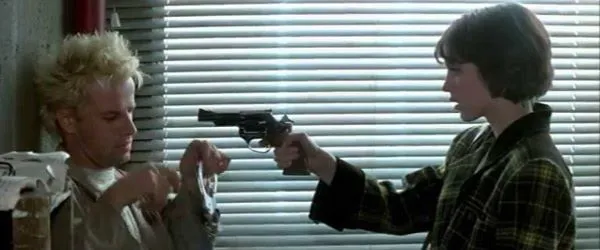Eye For Film >> Movies >> Subway (1985) Film Review

Subway opens with the intertitle:
To be is to do - Socrates

To do is to be - Sartre
Do be do be do - Sinatra
...and then it's straight into a car chase. It's not exactly a normal car chase. Four tuxedo clad men in an expensive sedan pursue a little Peugeot 205. The driver of the Peugeot, Fred (Christopher Lambert), also wearing a tuxedo, is taking no part in the chase. Instead Fred, with only one eye on the road, scrabbles around in the car's glove compartment for a cassette tape. Only after finding the tape and inserting it in the player does he deign to participate in the chase. Only when the music starts does he put the pedal to the metal.
The cars career through the streets of Paris, echoing the car chases in films like The French Connection, Gone In 60 Seconds and The Driver. The tape mangles, as those things were wont to do, and Fred's car crashes through an entrance to the Paris Metro. The men from the sedan give chase but Fred disappears into the maze of the Metro system.
Luc Besson undercuts the form and seriousness of the action scenes. During the car chase there is a slapstick element involving an old man (Lucien Fleurot) who is exercising in the street. From his dress and demeanour you would expect to find him in a French farce rather than a film like this. As the pursuers exit the sedan one of them, rather than giving chase, falls to his knees and pukes his guts up. This reaction to fear and danger isn't supposed to be in this type of sequence.
As Fred travels through the hidden parts of the Metro system, in a series of slightly disjointed scenes, he encounters the indigent population of the subway. These are not drug addicts and derelicts. They may be buskers, hucksters and petty criminals but they have their own culture and sensibilities. In a way they form an artistic underground.
The journey also takes Fred though scenes that draw on popular cinema: Star Wars and its clones; adventure movies; heists; and the American high school drama. Besson is celebrating these films, whilst at the same time comically subverting their conventions. Sometimes he does it with a little dose of reality. For instance, in one scene the police are beautifully choreographed, precisely fanning out across a Metro station. One cop gets his crotch stuck on a ticket turnstile. Sometimes it is overt. When Fred is trying to open the safe in police Commissioner Gesberg's (Michel Galabru) office he crouches down listening to the safe as he spins its dial safecracker style. Then suddenly he jumps up and legs it before a stick of Dynamite blows up the safe and half of the office with it.
As a film, Subway doesn't contain much of a plot. The incredibly wealthy Héléna Kerman (Isabelle Adjani) invited Fred to a party. Fred then steels documents from her well connected and criminally inclined husband's (Aleksandrov Konstantin) safe. After escaping, which is where the film starts, he ends up hiding out in the recesses of the Paris Metro trying to avoid the attention of the police and the husband's henchmen. He makes a meagre attempt at blackmailing Héléna over the contents of the stolen documents, then tries to become romantically involved with her. He also puts a band together under his management and has them perform a free concert in a Metro station. The narrative in the film isn't really about plot - it is about the transitions between tropes of popular art and film references. It is about the counterpointing of the popular with the stuffiness of well respected art, the harsh cold fluorescent light of the Metro station with the more humane darkness of the interconnecting conduits and forgotten spaces.
The visual spectacle of Subway is complemented by the score by Éric Serra. It ranges from bouncy Eighties pop (Speedway) to eerie industrial (Dark Passage II). Arthur Simms, as the band's singer, has an engaging vocal style.
Subway is an important part of cinéma du look. The deprecatory term was coined by the French critic Raphaël Bassan to describe the films of Luc Besson, Leos Carax and Jean-Jacques Beineix, considering them as style over substance. These filmmakers tended to press both plot and characterisation into the service of image and concept. In films like this one, Nikita or Betty Blue it is that style is substance: they are moving paintings. Their narrative is the narrative of the art gallery. The style isn't confined to France. It ranges from Michael Mann in the west to Mamoru Oshii in the east. It's in British adverts (Dunlop: Tested For The Unexpected; McEwans: Alive And Kicking) and music videos. It's in the aesthetics of early cyberpunk.
Reviewed on: 22 Jun 2025

















